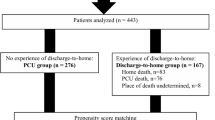Abstract
Information regarding advanced cancer patients followed at home who are admitted to the hospital in the last days of life are lacking. The aim of this study was to assess the characteristics of patients who were hospitalized in the last days of life after being assisted by a home palliative care team. The secondary outcome was to identify possible risk factors for hospitalization. The charts were analyzed of a consecutive sample of advanced cancer patients admitted to hospital wards in the last days of life after being followed at home by a palliative care team. Of 550 consecutive patients followed at home, 138 (25.1 %) were admitted to the hospital. Younger patients were more likely to die in the hospital. In a logistic risk analysis adjusted for age, patients with lung and head–neck cancer were more likely to die in the hospital. Patients having a female relative or a female consort as a caregiver were more likely to die at home. CAGE-positive patients (7.25 %), and patients with a shorter period of home assistance were more likely transported to hospital before dying (p = 0.00 and p < 0.024, respectively). The most frequent reason for hospital admission was dyspnea. Admission was more frequent to the oncology ward. Patients who were admitted to the hospital died after a mean of 10.2 days (SD 8.2, range 0–40). This study provides preliminary data on the risk factors of hospitalization at the end of life for advanced cancer patients followed at home.
Similar content being viewed by others
References
Beccaro M, Costantini M, Giorgi Rossi P et al (2006) Actual and preferred place of death of cancer patients. Results from the Italian survey of the dying of cancer (ISDOC). J Epidemiol Community Health 60:1241–1246
Shih CY, Hu WY, Cheng SY, Yao CA, Chen CY, Lin YC, Chiu TY (2015) Patient preferences versus family physicians’ perceptions regarding the place of end-of-life care and death: a nationwide study in Taiwan. J Palliat Med 18:625–630
Mercadante S, Porzio G, Valle A, Aielli F, Costanzo V, Adile C, Spedale V, Casuccio A, Home Care Italy Group (HOCAI) (2012) Emergencies in patients with advanced cancer followed at home. J Pain Symptom Manag 44:295–300
Gomes B, Higginson IJ (2006) Factors influencing death at home in terminally ill patients with cancer: systematic review. BMJ 332:515–521
Mercadante S, Vitrano V (2010) Palliative care in Italy: problem areas emerging from the literature. Min Anestesiol 76:1060–1071
Costantini M, Camoirano E, Madeddu L, Bruzi P, Verga D, Henriquet F (2003) Palliative home care and place of death among cancer patients: a population study. Palliat Med 7:323–331
Mercadante S, Valle A, Porzio G, Costanzo BV, Fusco F, Aielli F, Adile C, Fara B, Casuccio A, Home Care—Italy (HOCAI) Group (2011) How do cancer patients receiving palliative care at home die? A descriptive study. J Pain Symptom Manag 42:702–709
Porzio G, Ricevuto E, Aielli F et al (2005) The supportive care task force at the University of L’Aquila: 2-years experience. Support Care Cancer 13:351–355
Porzio G, Aielli F, Verna L, Martella F, Aloisi P, Ficorella C (2013) Integrating oncology and palliative home care in Italy: the experience of the “L’Aquila per la Vita” home care unit. Tumori 99:225–228
Pivodic L, Pardon K, Morin L et al (2015) Place of death in the population dying from diseases indicative of palliative care need: a cross-national population-level study in 14 countries. J Epidemiol Community Health. doi:10.1136/jech-2014-205365 (epub ahead of print)
Cohen J, Pivodic L, Miccinesi G et al (2015) International study of the place of death of people with cancer: a population-level comparison of 14 countries across 4 continents using death certificate data. Br J Cancer. doi:10.1038/bjc.2015.312 (epub ahead of print)
Kondo S, Shimazu T, Morizane C, Hosoi H, Okusaka T, Ueno H (2014) A retrospective analysis of factors associated with selection of end-of-life care and actual place of death for patients with cancer. BMJ Open 4(5):e004352
Sasao S, Tanabe K, Morita T, Takahashi T, Yasuda H, Kashii T, Sawada K, Tonomura M, Murakami N (2015) Facility-related factors influencing the place of death and home care rates for end-stage cancer patients. J Palliat Med 18:691–696
Chen H, Nicolson DJ, Macleod U, Allgar V, Dalgliesh C, Johnson M (2015) Does the use of specialist palliative care services modify the effect of socioeconomic status on place of death? A systematic review. Palliat Med (epub ahead of print)
Ahiner-Elmqvist M, Jordhoy M, Jannert M, Fayers P, Kaasa S (2004) Place of death: hospital-based home care versus conventional care. Palliat Med 18:585–593
Wallace SK, Waller DK, Tilley BC, Piller LB, Price KJ, Rathi N, Haque S, Nates JL (2015) Place of death among hospitalized patients with cancer at the end of life. J Palliat Med 18:667–676
Arnold E, Finucane AM, Oxenham D (2015) Preferred place of death for patients referred to a specialist palliative care service. BMJ Support Palliat Care 5:294–296
Author information
Authors and Affiliations
Corresponding author
Ethics declarations
Conflict of interest
The authors declare that they have no conflict of interest.
Statement of human and animal rights
This paper is based upon a retrospective analysis of event characteristics. No impact nor alteration in patient management was involved. Internal Review Board reviewed and approved this study as a retrospective analysis.
Informed consent
This is a retrospective study, for this reason informed consent was'nt obtained from all individuals participants included in the study.
Rights and permissions
About this article
Cite this article
Mercadante, S., Masedu, F., Valenti, M. et al. The characteristics of advanced cancer patients followed at home, but admitted to the hospital for the last days of life. Intern Emerg Med 11, 713–718 (2016). https://doi.org/10.1007/s11739-016-1402-1
Received:
Accepted:
Published:
Issue Date:
DOI: https://doi.org/10.1007/s11739-016-1402-1




